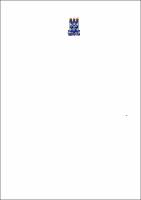| Compartilhamento |


|
Use este identificador para citar ou linkar para este item:
http://tede2.uefs.br:8080/handle/tede/1693| Tipo do documento: | Dissertação |
| Título: | Influência dos efeitos antrópicos, edáficos e vegetacionais sobre a estrutura populacional de Attalea pindobassu Bondar – babaçu, na caatinga |
| Autor: | Lima, Bárbara Alves de Oliveira  |
| Primeiro orientador: | Silva, Jhonathan de Oliveira |
| Resumo: | O surgimento de habitats antropizados afeta negativamente a biodiversidade e os serviços ecossistêmicos. Nestes habitats têm sido intensificados a exploração de produtos florestais não madeireiros. O babaçu (Attalea pindobassu Bondar), palmeira endêmica do Norte da Chapada Diamantina, Bahia, é uma espécie de elevado uso extrativista e importância socioeconômica. A região possui variados ambientes modificados através da remoção da cobertura vegetal, o que compreende um risco para espécies nativas. O estudo teve como objetivo avaliar as características estruturais de 14 populações de A. pindobassu em áreas com diferentes níveis de perturbação. Para populações em áreas de vegetação nativa, foram estabelecidas de três a seis parcelas de 30x15 m, com uma subparcela de 7x7 m para amostra de regenerantes. Em áreas de pastagem ou plantios de culturas agrícolas, foram estabelecidas de três a seis parcelas de 50x50 m, com uma subparcela de 5x50 m para regenerantes. Os indivíduos foram classificados em cinco estágios ontogenéticos: plântula, infante, jovem, adulto imaturo e adulto reprodutivo. Medidas quantitativas foram coletadas para classificar os estágios ontogenéticos a partir do tipo de folha, presença/ausência de estipe e presença/ausência de estrutura reprodutiva. Em geral, 92,8% das populações avaliadas apresentaram registros de indivíduos regenerantes. Quanto à distribuição das classes de tamanho, a maior parte das populações apresentou assimetria positiva, onde foi possível observar baixos níveis de ações antrópicas. Em relação à distribuição de classes de altura, 93% das populações obtiveram ajuste à curva de J-Invertido, demonstrando que há baixo interferência no processo natural de regeneração. Foi possível observar que a influência dos fatores antropogênicos afetou mais a densidade dos indivíduos do que fatores edáficos. Para todos os estágios ontogenéticos, a densidade dos indivíduos foi afetada negativamente por ações antrópicas, sendo estas a agricultura, criação de bovinos, colheita de frutos e extração de madeira. Por conseguinte, através do estudo foi possível observar como atividades provenientes da ação do homem podem afetar o ciclo de vida natural de uma espécie vegetal endêmica. A criação de planos de conservação e implementação de práticas de manejo são cruciais para a conservação da espécie. |
| Abstract: | The emergence of anthropic habitats negatively affects biodiversity and ecosystem services. In these habitats, the exploitation of non-timber forest products has been intensified. Babassu (Attalea pindobassu Bondar), a palm tree endemic to the North of Chapada Diamantina, Bahia, is a species of high extractive use and socioeconomic importance. The region has varied environments modified through the removal of vegetation cover, which poses a risk to native species. The study aimed to evaluate the structural characteristics of 14 populations of A. pindobassu in areas with different levels of disturbance. For populations in areas of native vegetation, three to six plots of 30x15 m were established, with a subplot of 7x7 m for sampling regenerants. In pasture areas or agricultural crop plantations, three to six 50x50 m plots were established, with a 5x50 m subplot for regenerants. Individuals were classified into five ontogenetic stages: seedling, infant, young, immature adult and reproductive adult. Quantitative measurements were collected to classify ontogenetic stages based on leaf type, presence/absence of stipe and presence/absence of reproductive structure. In general, 92.8% of the populations evaluated had records of regenerating individuals. Regarding the distribution of size classes, most populations showed positive asymmetry, where it was possible to observe low levels of anthropogenic actions. Regarding the distribution of height classes, 93% of the populations achieved adjustment to the Inverted-J curve, demonstrating that there is low interference in the natural regeneration process. It was possible to observe that the influence of anthropogenic factors affected the density of individuals more than edaphic factors. For all ontogenetic stages, the density of individuals was negatively affected by human actions, suchas agriculture, cattle breeding, fruit harvesting and wood extraction. Therefore, through the study it was possible to observe how activities resulting from human action can affect the natural life cycle of an endemic plant species. The creation of conservation plans and implementation of management practices are crucial for the conservation of the species. |
| Palavras-chave: | Arecaceae Atributos de solo Biodiversidade Extinção Perda de habitat Arecaceae Biodiversity Habitat loss Local extinction Soil attributes. |
| Área(s) do CNPq: | CIENCIAS BIOLOGICAS::ECOLOGIA |
| Idioma: | por |
| País: | Brasil |
| Instituição: | Universidade Estadual de Feira de Santana |
| Sigla da instituição: | UEFS |
| Departamento: | DEPARTAMENTO DE CIÊNCIAS BIOLÓGICAS |
| Programa: | Programa de Pós-Graduação em Ecologia e Evolução |
| Citação: | LIMA, Bárbara Alves de Oliveira. Influência dos efeitos antrópicos, edáficos e vegetacionais sobre a estrutura populacional de Attalea pindobassu Bondar – babaçu, na caatinga, 202-, 70f., Dissertação (mestrado) - Programa de Pós-Graduação em Ecologia e Evolução, Universidade Estadual de Feira de Santana, Feira de Santana. |
| Tipo de acesso: | Acesso Aberto |
| URI: | http://tede2.uefs.br:8080/handle/tede/1693 |
| Data de defesa: | 8-Mar- 202 |
| Aparece nas coleções: | Coleção UEFS |
Arquivos associados a este item:
| Arquivo | Descrição | Tamanho | Formato | |
|---|---|---|---|---|
| Lima, Barbara Alves de Oliveira - Dissertação.pdf | Lima, Bárbara Alves de Oliveira - Dissertação | 1,61 MB | Adobe PDF |  Baixar/Abrir Pré-Visualizar |
Os itens no repositório estão protegidos por copyright, com todos os direitos reservados, salvo quando é indicado o contrário.




